New blog address
The Climate and Environment at Imperial blog has moved. Visit our new blog.
The Climate and Environment at Imperial blog has moved. Visit our new blog.
by Alyssa Gilbert, Head of Policy and Translation, Grantham Institute
 It is just like some colossally awful house-bidding process. Only here it is not just an attractive three-bed semi-detached residence that is at stake. In the run up to the United Nations Framework Convention on Climate Change (UNFCCC) Conference in Paris in December, each country is submitting its bargaining chip, a so-called Intended Nationally Determined Contribution (INDC).
It is just like some colossally awful house-bidding process. Only here it is not just an attractive three-bed semi-detached residence that is at stake. In the run up to the United Nations Framework Convention on Climate Change (UNFCCC) Conference in Paris in December, each country is submitting its bargaining chip, a so-called Intended Nationally Determined Contribution (INDC).
The levels that countries put forward is part of the complex international climate negotiations – countries are keen to show genuine commitments to climate change action, but very few are willing to rush ahead of other nations. It is a classical prisoner’s dilemma.
Analysts and, quite frankly, those who care about climate change are waiting with bated breath to see what these commitments will add up to. Once each country has stated what it will do, how close will we be to the target of limiting global temperature rise to 2°C?
Announcements of INDCs are coming thick and fast, albeit months after the purported deadline. Last week saw a bumper crop of INDCs from Iceland, Serbia, South Korea and the long-anticipated Chinese contribution. These contributions bump us up to over 55% coverage of current global emissions, and 43% of countries.
So, the good news is, we are starting to see some commitments, but where does this take us? A good step-by-step update, complete with lovely infographic is regularly updated on The Carbon Brief .
The expert analysts at the Climate Action Tracker weigh up each of the INDCs to see what that means for the climate as a whole, and it is not looking good. The majority of countries assessed have commitments, and matching national policies, that fall within the ‘medium’ range – this means that they will not keep us within the 2°C limit.
Looking more specifically at last week’s key announcements, different national approaches give us a flavour of some of the key issues up for debate – the use of markets, the need for effective national policies and the potential and desire to overachieve.
Firstly the markets/no-markets debate. South Korea’s INDC is deemed inadequate by the Climate Action Tracker because it just doesn’t demand steep enough cuts to reduce our carbon envelope. In addition, the challenge of kick-starting a step-change in domestic emissions in this well-developed country will be exacerbated by a heavy reliance on international market-mechanisms, i.e. buying reductions achieved in other countries. Critics of this approach reveal a duality – on the one hand the use of more markets is lauded because it can bring down the global costs of reducing greenhouse gas emissions, whilst on the other hand, countries can use international markets as a way to avoid action at home.
The verdict on China has revealed a second interesting theme, emphasising that action through national policies is needed to make the INDCs effective. In fact, the Climate Action Tracker notes that China’s national policies fare much better than the overall carbon intensity target – which is a good sign, even if the overall trajectory still only scores a medium. A useful English translation of the China National Center for Climate Change Strategy and International Cooperation (NCSC)’s analysis of the INDC can be found here. This analysis emphasises some of the development, greenhouse gas monitoring (MRV) and other challenges that China will still face in delivering on its INDCs.
The importance of national policies should hit home here in the UK. In the same week as China released its INDCs, the UK’s Climate change Committee (CCC) noted that we are doing well, but not well enough (see report). In the end the INDCs need to translate to solid, effective actions within each individual country. And doing so successfully is far from easy.
For me, the third take home message is, as ever, political. It has been widely reported that the China’s overall INDC target is deliberately loose, to allow for overachievement. Let’s hope other countries rise to the competitive challenge – a race to overachieve would be a great way to try and beat the mediocrity of the current INDC commitments and ensure we meet the necessary level of ambition over the coming years.
Let’s all take a leaf out of China’s book – their INDC represents a challenging trajectory, but they are moving fast…..
The current analysis on the table provides information about just how hard it will be for countries to steer towards their stated goals. I will be a more frequent presence on the blogosphere from now on, pulling together my thoughts on climate change commitment and actions at all levels of government, and in business, in the run up to Paris but also, and more importantly, beyond!
Follow Alyssa on Twitter: @AlyssaRGilbert
By Dr Flora Whitmarsh, Grantham Institute
The recently published 2015 Global Peace Index , produced by the Institute for Economics and Peace, said that although OECD countries became more peaceful in 2014, there has been substantial increase in annual war-related deaths since 2010, and there are now more refugees than at any time since the Second World War. It is currently difficult to give a definitive answer as to whether climate change could exacerbate these problems.
, produced by the Institute for Economics and Peace, said that although OECD countries became more peaceful in 2014, there has been substantial increase in annual war-related deaths since 2010, and there are now more refugees than at any time since the Second World War. It is currently difficult to give a definitive answer as to whether climate change could exacerbate these problems.
Climate change is likely to exacerbate a range of environmental problems including heat waves, water shortages, and extreme weather and flooding, but whether or not this will lead to increased rates of armed conflict is still the subject of research. According to the IPCC’s Fifth Assessment Report, some of the factors that increase the risk of conflict – recession, low per capita incomes, and inconsistent state institutions – are sensitive to climate change, but this does not necessarily mean that climate change will lead directly to higher rates of war and unrest.
Environmental factors more generally do play a key role in triggering unrest. An example of this is the role of water shortages in causing the recent Syrian war: farmers who had lost their livelihoods were forced to migrate to the cities, where they struggled to integrate and find work. The resulting uprisings then played a part in triggering war. Although conflict is sometimes triggered by a single environmental problem which acts as a tipping point, environmental factors usually combine with other factors to exacerbate war and unrest.
In his book, Global Crisis: War, Climate Change and Catastrophe in the Seventeenth Century, Geoffrey Parker argues that the unusually cool conditions (a 3 degree lower global temperature) during the seventeenth century “Little Ice Age” played a key role in sparking the steep rise in conflict sometimes referred to as the General Crisis. Surviving records from Europe and Asia paint a picture of extremely widespread famine and instability. In Europe for example, almost no country avoided war during the 1640s, and between 1618 and 1678, “Poland was at peace for only 27 years, the Dutch Republic for only 14, France for only 11, and Spain for only 3.”
Parker argues that the seventeenth century environmental deterioration caused by a decrease in solar energy reaching Earth and an increase in volcanic and El Niño activity has had “few parallels” and that “the frequency of wars and state breakdown created unprecedented political, social and economic instability.” Although the modern world is more integrated than the world of the seventeenth century, the argument linking periods of environmental instability with increased rates of conflict is potentially applicable to human induced climate change.
Dr Mark Workman of Imperial College London said, “The hypothesis for the causes of the General Crisis is very compelling”, but cautioned that “in the modern globalised and increasingly interconnected world the causative mechanisms are very controversial and I think the jury’s still out as to the degree to which environmental impacts are important as a cause in contemporary conflict.”
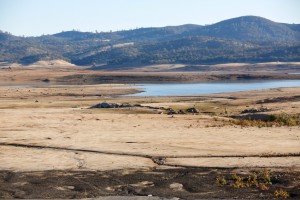
But environmental problems don’t always lead to conflict. “One thing that’s been missing from the current narrative is that there are opportunities for confidence building measures and co-operation,” says Dr Workman. Disputes over trans-boundary rivers often lead to increased cooperation because neighbouring regions or countries have an incentive to work together to make sure water is distributed fairly. “As history has demonstrated, through confidence building measures and sensible mechanisms of water allocation or resource allocation you can actually find ways to make one plus one equal two”, continued Dr Workman.
More research is needed to explain the precise mechanisms by which environmental factors spark conflict, and how this relates to climate change. Key to this is acquiring more and better data. Relevant data can be hard to obtain at present; for example the global FAO food price index is of little use in evaluating stressors in Tunisia and Syria, both of which have very localised food markets. In addition, research has tended to centre on the Middle East and North Africa Region, so there is a need for more widely applicable research.
A high proportion of global conflicts currently occur within, rather than between, countries, which would also apply to conflicts involving environmental problems, so future work is likely to focus especially on this area. Dr Workman says, “Environmental enhanced conflict will be more a subnational manifestation, because there is world trade at a national level, whereas within fragile conflict-affected states, which are home to nearly 20% of the world’s population, there are limited trade and transport mechanisms to address the resource arbitrage.”
With its wealth of technical expertise, the Grantham Institute at Imperial College London is well placed to bring together the fragmented work and carry out new research in this area. There will be three key steps involved in taking this forward. First, knowledge gaps need to be identified. Second, theories about how conflict interacts with environmental factors need to be verified using case studies. The third and most challenging step is developing ways of predicting how environmental factors may exacerbate or cause conflict in the future.
A publication released last week has highlighted an agenda for research.
by Dr Kris Murray, Grantham Lecturer in Global Change Ecology
 Today the Lancet Commission on Health and Climate announced the release of their new report “2015 Lancet Commission on Health and Climate Change: Policy Responses to Protect Public Health”.
Today the Lancet Commission on Health and Climate announced the release of their new report “2015 Lancet Commission on Health and Climate Change: Policy Responses to Protect Public Health”.
Following a first report released in 2009, which concluded that “Climate change is the biggest global health threat of the 21st century”, today’s report has a proactive, positive take-home: “tackling climate change could be the greatest global health opportunity of the 21st century.”
Strategically released following the 68th World Health Assembly held last month and in the lead up to the UNFCCC’s COP21, to be held in Paris later this year, the report is the culmination of a second international (predominantly Chinese-European) working group assembled to assess the health impacts of climate change and to identify and accelerate effective mitigation and adaptation policies over the next 5 years.
The report provides 9 recommendations and delivers 1 promise:
Accompanying the launch of the report, the Lancet Commission on Health and Climate are holding a number of events around the world (including London, New York and Canberra), which will include speakers, panel discussions and an opportunity for Q&A from participants. The Health and Environment Alliance will also host a virtual launch event.
While the recommendations are not exactly breaking radical new ground, they do represent a welcome synthesis of the front-line evidence on the health impacts of climate change with a clear focus on solutions (the details of which make up the bulk of the report).
Perhaps more critically, they also crank up the volume of the voice of the health community at a critical time in the climate change arena – a voice that has a formidable track record of achievement in confronting other highly complex, trans-national, politically charged threats to health.
For further comment on the report, see the Lancet website.
Building resilience to extreme weather needs a systems approach, including institutional ‘software’ as well as technical, financial, and physical infrastructure – or ‘hardware’. Designing, financing, achieving and evaluating success in the intangible aspects of resilience is challenging. Illustrating the systems approach to this challenge, the International Institute for Environment and Development (IIED) has been supporting the government of Kenya to invest in social software as a means to manage variable resource availability in the northern drylands.
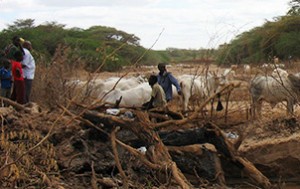 Between 1980 and 2012, it is estimated that the annual damage from extreme-weather related events rose from $20b to 150b, totalling close to US$2 trillion, of which only ¼ was insured. Examples include floods in Bangladesh and Thailand, typhoons in the Caribbean and droughts in the West African Sahel and Horn of Africa. Poor people and nations have been particularly vulnerable to the impacts of these events; people living in countries with a low Human Development Index make up only 11% of those exposed to hazards but account for 53% of disaster mortality.
Between 1980 and 2012, it is estimated that the annual damage from extreme-weather related events rose from $20b to 150b, totalling close to US$2 trillion, of which only ¼ was insured. Examples include floods in Bangladesh and Thailand, typhoons in the Caribbean and droughts in the West African Sahel and Horn of Africa. Poor people and nations have been particularly vulnerable to the impacts of these events; people living in countries with a low Human Development Index make up only 11% of those exposed to hazards but account for 53% of disaster mortality.
Even if we manage to cut greenhouse gas emissions rapidly and effectively from today, we must anticipate 20-30 years of growing impacts from climate change due to lags in the global atmospheric system. Drought, floods, and heat waves are all likely to increase in both frequency and intensity. The impact of tropical storms and associated sea surges will be amplified by sea-level rise. Disaster preparedness is key to help minimise loss of life and property, as well as speeding recovery post-disaster. ‘Resilience’ has become a widely used term to describe the quality of human-environment systems and their response to disaster. More than merely coping with individual extreme weather events, however, it means “looking at the capacity of individuals, communities and systems to not only survive, but also adapt and grow in the face of stress and shocks.”
Building resilience to extreme weather needs a systems approach, which involves investing in a combination of technical, economic/financial, and institutional dimensions. When faced with a threat such as drought or flooding, the first instinct is to invest in hardware – such as dams to capture and store water for dry periods, or sea-walls to protect from floodwater. And such tangible infrastructure is clearly very important. But alongside such investment in the physical hardware of protection, there are a range of vital intangible investments needed in the software of institutions for managing variable resources, and sharing risk. Institutions may be invisible, but their strength can make a big difference in how societies cope with disaster. Building resilience also requires shared action and responsibility at local, national and international levels, by the public and private sectors, local communities and non-governmental organisations. We will use the case of northern Kenya to illustrate this systems approach, and the role that different actors need to play.

Investing in local institutions in Northern Kenya
With funding from the UK’s Department for International Development (DFID), IIED has been supporting the government of Kenya to build resilience in the northern drylands. Over the last 15-20 years, this large drought prone region has suffered more intense and frequent drought events. Climate predictions for Kenya anticipate increasing frequency and severity of droughts and floods.7 The extended drought of 2008-11 caused livestock losses estimated at around 40-60% in some parts of Isiolo County. With an expectation of five years or less between drought events, there is not enough time for herds to recover from losses of such magnitude. This has a devastating impact on people’s livelihoods, since 80% of the population are dependent on livestock.
The new Constitution of Kenya affirms a strong decentralised approach, better to address the priorities of local people through putting decision-making into their hands. Equally, the government has recognised the long-standing marginalisation of pastoral livestock keepers in this large northern region, and the need for a revised approach which understands the rationale for herd mobility. Keeping animals mobile makes the best use of seasonally variable grazing and water resources, as well as helping people manage with unexpected rainfall and pasture change. This means having collective management of large areas of grazing, and the ability of different groups to move herds between areas. Key elements to support this mobility include recognised ownership and management rights, co-ordinated by community groups, and flexible access arrangements. Working with traditional institutions to invest in water points is frequently the key-stone to better management of surrounding grazing.
Amongst the Boran people of Northern Kenya, the Dedha is a customary neighbourhood institution for management of natural resources. Local Dedha councils identify which grazing areas need to be set aside for drought reserves – in these areas no one should graze their animals except during drought periods. The Dedha decide when these rules should apply and ensure such decisions are respected by herders. Young men are trained to patrol pasture and water areas to make sure people adhere to the rules.
Since 2011, IIED has been working to help establish the Isiolo County Adaptation Fund, as a pilot to be managed at the county level, ensuring funds are prioritised by vulnerable communities to build their own resilience. The fund has supported a range of investments, which include rehabilitating sand dams, digging new boreholes, fencing of critical areas and setting up a radio station.16 In particular, the fund has supported activities to strengthen the Dedha. By designating and directing herds to areas of seasonal grazing during the wet season, these customary bodies conserve high value grazing and water for use over the dry season.
Evaluating the benefits of investing in institutions
By the middle of 2014, drought conditions had worsened across the north of Kenya and the National Drought Management Authority (NDMA) was reporting a rapid decline in climatic, vegetation and socio-economic indicators across Marsabit, Wajir and Garissa counties. But in Isiolo alone, animal health, child nutrition, and livelihoods seemed to have been less affected by the worsening drought.
It can be difficult to estimate the impacts of such efforts to strengthen the Dedha vis-à-vis what might have happened had these interventions not been undertaken. Working with the Dedha in an effort to conduct such an analysis, IIED carried out a participatory assessment to estimate the benefits gained from better management of dry season grazing and drought preparedness, in terms of livestock survival rates, milk production, and reduced disease incidence.
Shortly after this assessment with the Dedha was carried out, rains arrived in most parts of the county and fortunately a full-blown drought emergency did not develop.Nevertheless, the Dedha members argued that by October 2014, livestock mortality rates would have been as high as in previous drought years, if they had not set aside drought reserve areas.
Although milk production usually stops in the long dry season and animals get sick more often, in 2014 these impacts did not occur. An estimate was made of the value of milk produced at this time and expenditures on medicines avoided, which were added to the estimated annual income to the Dedha from livestock sales. This partial identification of benefits from adaptation could then be compared with the costs of investment, both through the Isiolo County Adaptation Fund, and the contributions made by local people.
Because the NDMA datasets showed that the vegetation conditions during 2014 were not in fact as bad as they had been during the 2011 drought, this introduced doubt concerning the levels of avoided livestock mortality estimated by the Dedha. Since it was not possible to verify what level of livestock mortality would have occurred during 2014 without theDedha’s interventions, the value of all avoided mortalities that the Dedha members had identified was removed from the calculation of benefits achieved during 2014. Even on this basis, Dedha members had still secured a remarkable return on their investment of at least 24:1. But had the rains not arrived when they did, and a serious drought occurred, the value of the avoided mortalities would be included in the return on the investment. This would then have yielded returns almost as high as 90:1.
In addition to the local herds, livestock and people from neighbouring counties migrated into Isiolo. This helped them reduce their livestock losses and maintain milk production, and household nutrition – key benefits of particular value to women. The value of these additional benefits from the Dedha’s natural resource stewardship to the communities that they hosted from areas outside the county was even greater than the value of benefits received by Dedha members themselves. The market value of dry season milk produced by the animals belonging to the displaced pastoralists was 342 times the Isiolo CAF investment in strengthening the Dedha and 50 times the cost of the entire DFID program (£455,687, including all of its start-up, overhead costs, and all funds spent on all types adaptation projects, not just the institutional strengthening of the Dedha).
A broad range of other beneficial effects on the economy and society were noted but could not easily be valued. These included the reduced need to migrate long distances for water and pasture, resulting in reduced security risks and increased time spent at home with family and time spent taking care of local business. Strengthened local institutions enhanced the voice of local leaders and created employment for young men who played a key role in resource surveillance, as well as reducing dependence on food handouts and social assistance. If these benefits could also be quantified, they would demonstrate the very significant return on investment in natural resource management to both local families, and the public finances of Isiolo and the surrounding counties.
Building resilience for the future
In the coming years societies around the globe will need to find ways to build greater resilience to extreme climate events in this warming world. Investment in physical infrastructure, the hardware of disaster resilience, needs to be matched by strengthening of intangible but powerful institutions that help people manage risks and achieve collective agreement on how resources are best used. The example of the Dedha in northern Kenya shows the considerable returns gained from investing in social software, by re-establishing customary management systems, as a means to manage variable resource availability. While much of the work and investment is made locally, its ability to operate effectively relies on the national level framework to decentralise power and decision-making to county level. Equally, the funds from international donor agencies, such as the UK’s DFID, have helped make this pilot possible, from which it is hoped that many other such initiatives can learn.
Camilla Toulmin is Director of the International Institute for Environment and Development (IIED). Daoud Tari is a Visiting Fellow at IIED and leads the Resource Advocacy Programme (RAP), a community trust based in Isiolo County, Kenya. Caroline King-Okumu is a Senior Researcher working for IIED’s Climate Change Group. The work described in this article has been undertaken by IIED in collaboration with many colleagues from Kenya, especially Ibrahim Jarso, Hildah Kathare, Lordman Lekalkuli, Luigi Luminari, Nelson Mutanda, Nour Godana, Mumina Bonaya, Cynthia Awor, Jane Kiiru, Victor Orindi, and IIED colleagues Morgan Williams, and Kate Green.
This blog first appeared on ANGLE. View original for full references.
A Global Village, Imperial College London’s science and policy journal, is relaunching as ANGLE, an online only journal focusing on the intersection of science, policy and politics in an evolving and complex world. Visit ANGLE
By Clea Kolster, PhD student, Science and Solutions for a Changing Planet

The term ‘sustainable development’ was first coined in 1987 in the UN’s World Commission on Environment and Development report, Our Common Future. Almost 30 years later, the concept of sustainable development is more relevant than ever.
The definition given in the report is, to this date, the most widely accepted modern definition of the term: ‘Sustainable development is development that meets the needs of the present without compromising the ability of future generations to meet their own needs.’ Climate and society, energy, water, ecosystem health and monitoring, global health, poverty, urbanization, natural disasters, food, ecology and nutrition – these are some of the main problems that need to be tackled when discussing the possibility of sustainable development. They are all complex problems that require an interdisciplinary and analytical approach. Earlier this year, I joined a group of people doing just that.
On Friday April 3rd 2015, I entered the land of Ivy League elites of Columbia University to take part in the 5th Annual Interdisciplinary PhD Workshop on Sustainable Development. Having been on a year abroad at Columbia University during my undergraduate degree, I knew the spot pretty well and was thrilled about getting the chance to come back as a matured and informed PhD student ready and eager to present my work.
Arriving at the workshop, I struck up a conversation with some of the students around me. I quickly understood that a number of us had made the cross-Atlantic trip, with participants from Denmark, Italy, Sweden, France and even Australia. Students also came from Canada and Mexico, with a large majority attending world-renowned US universities, including Harvard, MIT, Yale, Princeton, UC Berkeley and of course Columbia.
The highlight of the first day was a keynote speech by American economist Jeffrey Sachs, head of the Earth Institute at Columbia University., Sachs has an incredible track record: he is a Quetelet professor (honorary distinction given to Columbia University professors, awarded to only four professors since 1963) of Sustainable Development, special advisor to Ban Ki-Moon, youngest economics professor at Harvard University (age 28), author of three New York Times bestsellers – and the list goes on.
One of the things that engrossed me most was his emphasis on planetary boundaries and the current ideological conflict between growth (mostly economic) and environmental sustainability. Sachs definitely got the whole room thinking about whether or not sustainable development is actually feasible and, for those like myself who desperately want that answer to be positive, what one can do to bring us closer to that goal: a world with sustainable economic, social and environmental objectives.
The rest of the afternoon featured sessions on a variety of topics from natural disasters – including the Venetian example of floods – to urban planning in China and development in India. After a long afternoon of presentations, I got the chance to network and socialize with the students. I met some very interesting individuals, most of whom, contrary to myself, feel as though they are economists before anything else, in spite of an earlier education in engineering.
On the second day, I was due to give my presentation as part of the Energy. In a small room filled with 10-15 other PhD students, all of whom were senior to me, and a few professors, I sat nervously waiting for my turn, beginning to realize that my presentation was clearly going to be one of the most “engineeringy” and technical of all.
I finally gave my 20 minute talk on the “Techno-Economic Analysis of the Link between Above Ground CO2 Capture, Transport, Usage for Enhanced Oil Recovery (EOR) and Storage”. I was happy to take some interesting questions at the end of it (which I hoped meant that the audience was actually interested by my topic) and later on at the coffee reception engaged in some stimulating discussions with some of my peers. It was clear that in spite of our dissimilar approaches, we had all contributed to responding to the question of sustainable development and its feasibility.
Did you know that 1.4 billion people currently live in a state of extreme poverty at below $1.25/day? In fact, it will take a 4 to 5 time increase in total global output by 2050 to get poor countries to meet the $40,000 per capita income of rich countries today. With figures like these, it isn’t surprising that large groups of individuals around the world dedicate their time to assessing and analyzing the best ways of achieving sustainable development encompassing economic, social and environmental goals.
In my view, sustainable development is feasible, we can tackle climate change, we can reduce our exploitation of natural capital while promoting economic growth, we can bridge the gap between poor and rich countries; the problem is – as Jeff Sachs pointed out – a lack of trust. A lack of trust leads to social and political instability and these will always impede sustainable development around the world.
References
World Commission on Environment and Development – Bruntland Commission. 1987. Our Common Future. s.l. : Oxford University Press, 1987.
Find out more about Clea’s research
Professor Jo Haigh, Co-director of the Grantham Institute reports back from the Climate Parliament meeting in Lucerne, 12 June 2015.
 I have just found a seat on the train from Lucerne to Zurich airport. It is absolutely packed, I suppose, with people going away for the weekend. Staring through the window at the snow-capped mountains, and having spent the day at an inspirational conference set by the beautiful lake, I am wondering quite why anyone would want to leave.
I have just found a seat on the train from Lucerne to Zurich airport. It is absolutely packed, I suppose, with people going away for the weekend. Staring through the window at the snow-capped mountains, and having spent the day at an inspirational conference set by the beautiful lake, I am wondering quite why anyone would want to leave.
I have been at a meeting of the Climate Parliament. I only learned of this organisation recently but it is rather splendid – a group of legislators from across the world who are concerned about climate change and looking to influence governments to act. Seventy attendees came together to discuss the potential for a Global Energy Internet: an international electricity grid based on regional renewable energy sources.
Attendees were diverse – including MPs from four continents, industrialists, academics and representatives from energy and climate agencies. Simultaneous translation was provided between French, Spanish, Chinese and English, although that can’t have covered all the first languages represented. Fortunately my talk was first up so I could then concentrate on the rest.
For me a highlight was Li Junfeng, Director General of the Chinese National Centre for Climate Change Strategy and International Cooperation, who spoke on China’s energy demands, provision and ambitions for decarbonisation. He spoke of a “solar Silk Road for the 21st century” and noted the need for revolutions in energy production and for technical innovation with international cooperation on R&D in renewables: “Helping China is helping the World” he said.
Lei Xianzhang, of the State Grid Corporation of China, was up next discussing some of the technical issues and describing the construction of new wind and solar plants (grown by factors of 37 and 350 respectively since 2006) as well as very long (thousands of kilometres) high voltage DC transmission cables.
 The political and technical challenges which have faced attempts to construct an energy grid across the Middle East and North Africa were elaborated by Tareq Emtairah, Director of the Centre for Renewable Energy and Energy Efficiency in Cairo. In the absence of an electricity market there has been very little exchange coordinated to date, but the delegates from Jordan, Morocco and Tunisia remained upbeat.
The political and technical challenges which have faced attempts to construct an energy grid across the Middle East and North Africa were elaborated by Tareq Emtairah, Director of the Centre for Renewable Energy and Energy Efficiency in Cairo. In the absence of an electricity market there has been very little exchange coordinated to date, but the delegates from Jordan, Morocco and Tunisia remained upbeat.
National energy security concerns were foremost in the minds of colleagues from Senegal and Peru. Efforts to connect to international grids were seen as a second priority. I could see their point, but perhaps they were reassured that the proposed networks could be established to the advantage of all.
Damien Ernst, an energy economist from the University of Liège, delivered an inspirational message: his calculations suggest that large scale facilities of solar and wind energy, with long transnational interconnections can provide energy cheaper than fossil fuels. Construct the grid first, he declares, and the incentive to develop renewables will follow.
It is a shame I have to miss tomorrow’s discussions, which will focus on finances and start to develop an action plan, but I have to attend my father’s 90th birthday party. If I live to 90, or 80, or even 75(?) perhaps I will see established an international energy internet. It is a fantastic vision.
by Dr Erik van Sebille, Grantham Lecturer in Oceanography and Climate Change
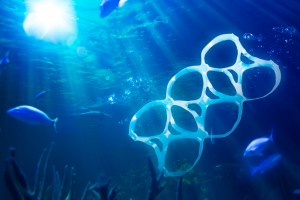 Our oceans are filthy with plastic. Most attention so far has focused on the bottles, carrier bags and other junk floating in the middle of our oceans. Some say that we ought to go out there and clean the stuff up. But a series of recent high-profile studies suggest that this stuff is only 1% of all the plastic in our oceans. The question on this World Oceans Day 2015 is, where is the other 99%?
Our oceans are filthy with plastic. Most attention so far has focused on the bottles, carrier bags and other junk floating in the middle of our oceans. Some say that we ought to go out there and clean the stuff up. But a series of recent high-profile studies suggest that this stuff is only 1% of all the plastic in our oceans. The question on this World Oceans Day 2015 is, where is the other 99%?
It’s hard to imagine a life without plastics, and this awesome material has greatly advanced our standard of living. However, some of this plastic ends up as waste in our ocean, where it clearly doesn’t belong.
A recent inventory in the journal Science estimated that around 10 million metric tons of plastic entered the ocean in 2010 alone.
However, two independent surveys have found that all the plastic bobbing around on the surface of the ocean weighs less than 100,000 metric tons.
So the amount of plastic at the ocean surface is two orders of magnitude lower than the amount of plastic that entered the ocean in 2010. Even with the large uncertainty margins on all these estimates, the conclusion must be that most of the plastic in the ocean has gone AWOL.
There are not too many places where the remaining plastic can be. It’s either on the seafloor, in the stomachs of animals, or on shorelines. The problem is that we don’t even have ballpark figures of how much plastic is in each of these places.
We know that there is probably a lot of plastic on the seafloor, where it impacts small critters crawling around. Not all plastic is buoyant enough to float, so some of the plastic will sink very quickly after it enters the ocean. Other plastic may float for a while but over time become so heavy with algal growth that it starts sinking. Unfortunately, we have only a few localised samples of plastic on the seafloor, and no idea how to scale these up to the entire ocean.
The second reservoir, inside animals, is probably the most worrisome of all. Most plastic that enters the ocean gets fragmented by wave action and sunlight, and after a few months to years ends up as tiny microplastic pellets. These tiny pellets might be quite easily ingested by large plankton and small fish. However, once again we have no clue how much plastic we are talking about globally.
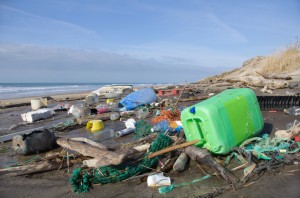 The shorelines, finally, would be my personal bet on where most of the plastic ends up. My own research at the Grantham Institute has shown that currents move plastic around in complex ways and it can linger near the shore for months. Much of the plastic that enters the ocean could just wash up with the next big storm.
The shorelines, finally, would be my personal bet on where most of the plastic ends up. My own research at the Grantham Institute has shown that currents move plastic around in complex ways and it can linger near the shore for months. Much of the plastic that enters the ocean could just wash up with the next big storm.
Shorelines come in many forms, from beaches to rocky outcrops to mangroves, and most of them are very remote and littered with plastic. Even the seemingly clean ones here in the UK might actually receive a lot of plastic, but volunteers and local councils clean them up at such a rate that we don’t realise just how filthy they are. There are great apps to report plastic on beaches, and widespread use of them would really help science.
We need to know where our plastic ends up if we want to understand its impacts on marine animals and ecosystems. And crucially, we need to stop polluting and remove plastic waste as close to the source as possible. Engineers are starting to think about how to do this with contraptions such as the Baltimore Waterwheel, but more bright ideas are needed.
If the case of our missing trash shows us anything, it’s that plans to clean up the floating plastic in the middle of the ocean do not really address the biggest problem. It would be far more effective to make sure no plastic ever enters the ocean in the first place. A stitch in time saves nine.
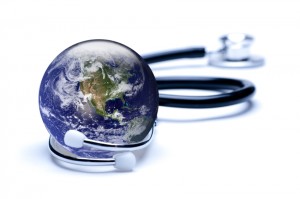
Dr Kris Murray, Grantham Lecturer in Global Change Ecology
Our planet is ill. Ongoing loss and endangerment of species, degradation of marine and terrestrial ecosystems and their services, and manmade changes to the global climate are dramatic symptoms of a major decline in the planet’s environmental health.
In glaring contrast, human health has improved, in some cases radically. Decreases in malnutrition, mortality due to infectious diseases and infant mortality rates, accompanied by substantial increases in life expectancy, can be observed in every major region of the world.
So why is health winning a war, while the environment is losing one?
At a fundamental level, there is a huge difference in investment. Human health is a global priority and survival, healthiness and well-being are personal objectives for almost everyone. Preservation of the environment simply isn’t. Spending on global health, for example, is at least an order of magnitude greater than for environmental conservation.
But surely it’s not that simple. Ecosystem services and human health and well-being are supposed to be deeply interconnected, right? So how can we observe declining ecosystem services on the one hand and improving health and well-being on the other?
This question, sometimes referred to as “The Environmentalist’s Paradox”, has been used to suggest that the connections between environment and health are really not that important for the future of human welfare, despite some examples (such as the emergence of novel infectious diseases) that might suggest otherwise.
Alternative explanations for the Paradox do, however, exist.
One is that while total ecosystem services value may be falling, some services on which health is more fundamentally dependent continue to increase (e.g., provision of food).
Another is the suggestion that technological advances can and have resulted in a degree of de-coupling of health from nature.
Finally, time lags could mean that accrued and ongoing losses of ecosystem services and natural capital may yet toll health and well-being on much larger scales in the future, a factor that is thought to have contributed to previous civilization collapse.
At least one review of the evidence suggests that elements of each of these explanations remain plausible, while others are also presumably possible.
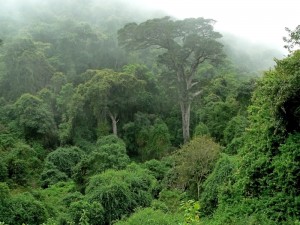 To my mind, this means that compiling old and discovering new efficiencies in those areas of potential overlap between environmental and human health is looking increasingly like a very sensible strategy. In other words, there are still huge opportunities and a pressing need to identify and leverage health gains to help stem environmental losses. And vice versa.
To my mind, this means that compiling old and discovering new efficiencies in those areas of potential overlap between environmental and human health is looking increasingly like a very sensible strategy. In other words, there are still huge opportunities and a pressing need to identify and leverage health gains to help stem environmental losses. And vice versa.
In fact, from global targets on climate change mitigation and biodiversity conservation to disaster risk reduction and sustainable development, identifying potential and demonstrating genuine health ‘co-benefits’ is a growth industry. This approach is increasingly being used to find, and fund, mitigation and adaptation actions to address global environmental challenges.
The New Climate Institute, for example, estimates that more ambitious emissions reductions targets in the EU could prevent around 40,000 premature deaths per year from air pollution and create around 350,000 jobs in the domestic renewables sector.
Similarly, the UK’s Natural Capital Committee reports that investing in equitable access to green spaces would pay off with improved physical and mental health, generating savings of around £2.1 billion per year.
And perhaps a tad more abstractly, the Centre of Global Health Security highlights how successes in global environmental governance could be leveraged for better global health governance. This illustrates not only the potential breadth of co-beneficial links between environment and human health, but that not all of them necessarily require a natural capital accounting framework to take seriously (although this is clearly helping!).
So while the pursuit of win-win solutions for the environment and health in isolation is potentially an unhealthy obsession, when better to try than on World Environment Day? Working through the costs and trade-offs that typically follow can wait, at least until tomorrow.
Find out more on Grantham research on environmental change and health

by Roan du Feu, PhD student, Science and Solutions for a Changing Planet
The marine renewable energy sector is poised and ready, waiting to harness the power of tides and waves with underwater tidal turbines and floating wave energy converters. A shift to renewable energy sources is essential to reducing global carbon emissions, but what are the consequences of these new technologies? Are we prepared for the effects of filling our already fragile oceans with rows of large, moving structures? Will we cause irreparable damage? Or might there even be some positive effects?
These are all questions relevant to my thesis and so, for two weeks, I attended a course on Marine Renewables and the Environment held at SAMS (the Scottish Association of Marine Science). The aim of this course was to explain the interactions between the abundant and varied ecology of the seas and the devices that will inevitably be placed in the midst of them.
SAMS is one of the oldest oceanographic organisations in the world and one of Europe’s leading research centres for marine science. It takes a great interest in marine prosperity and sustainability, climate change and, crucially, renewable energy. SAMS is located next to Dunstaffnage castle on a wild and exposed spit of land just north of Oban, Scotland, where the sinuous Loch Etive breaches into the grand, island-studded Firth of Lorn.
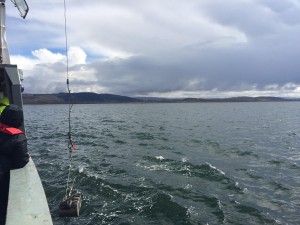
Over the course of two weeks we studied all forms of marine life. The flora ranged from the tiny, sometimes unicellular, phytoplankton and drifting algae, to the larger seaweeds. The fauna, a rather more extensive group, covered zooplankton, sponges, hydrozoa (including jellyfish and coral), segmented worms, molluscs, crustaceans, echinoderms (starfish and urchins, for example), bryzoans (moss animals), ascidians (sea squirts), fish, and of course the many marine mammals and seabirds that live and feed in the marine environment.
Something that struck me was the vast disparity, between the variety of marine flora and fauna. The dependence of plants on light to photosynthesise is at least partially responsible. The turbidity of British seas means that larger plants can only survive to a depth of about 25m, and even phytoplankton only descend to about 50m. Marine fauna on the other hand have no such limit, and can thrive many kilometres below the surface.
Marine renewable devices can have both negative and positive impacts on these many types of life. But what was made very clear was the great uncertainty in the extent and degree of almost all of these effects.
The most commonly discussed consequence of tidal turbines is blade strike. This represents a potential issue for marine mammals, large fish / sharks, and various types of diving bird, many of which dive well below the depth at which you might expect to find a turbine (guillemots, for example, have demonstrated the almost unbelievable ability to dive up to 180m below the surface in their search for fish). The extent of this problem is completely unknown, it is possible that such animals will be adept at avoiding turbine blades, but it is possible they will not.
T hen there is the noise produced during both the construction and the operation of such devices. This could potentially scare off or disorientate some marine mammals (or during pile driving even deafen them) while possibly attracting other more curious species. In this case mitigation techniques such as using bubble shields to damped sound during construction could the limit negative effects.
hen there is the noise produced during both the construction and the operation of such devices. This could potentially scare off or disorientate some marine mammals (or during pile driving even deafen them) while possibly attracting other more curious species. In this case mitigation techniques such as using bubble shields to damped sound during construction could the limit negative effects.
Another interaction that was heavily discussed was that of the artificial reef effect. Whatever the marine renewable device in question, one immediate change to the local environment will be the addition of large, sometimes complex, structures which provide a new, different habitat type upon which life can and will grow, often significantly increasing the biomass of the area.
This is not necessarily a good thing as structures in the water have been known to provide stepping stones for invasive species that are otherwise unable to cross wide channels. This influx of both floral and faunal growth will attract fish which in turn will attract marine mammals and seabirds into a, potentially, dangerous area. In fact, considering that fish also like to hide in the shelter given by these structures, and that such areas will likely become no fishing zones it seems probable that a marine renewable development could become a veritable haven for fish. Whether the knock-on effects of this, on other marine life or indeed on fishermen, are positive or negative is unknown.
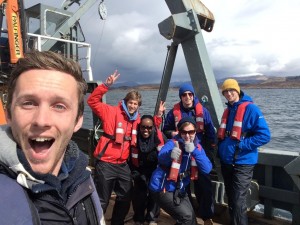
The main thing I am now aware of is the high levels of uncertainty in expert opinion. I had assumed that putting devices in the sea would be an inherently bad thing for the local environment (although good for the world at large), but is it? Possibly, sometimes, but we don’t yet know. Then I was told of all the life that would actually be drawn to such devices, surely that’s good? Possibly, sometimes, but we don’t yet know.
The introduction of marine renewables to the seas is inevitable. It is one of many things that has to happen if we hope to combat the inescapable advance of man-made climate change. But I have learned that it has to be done with care, it has to be monitored well, and the information gathered has to be put to use. It seems possible that such technology could be implemented without contributing to the decline of the oceans, but only as long as it is done in an appropriate and measured manner. For what is the point in trying to save the planet if we end up destroying it in the process?
Read more about Roan’s PhD project
By Dr Flora Whitmarsh, Grantham Institute
 Although both Labour and the Liberal Democrats have pledged to decarbonise the electricity sector by 2030, climate change is unlikely to be a key issue in the run up to the May general election. This reflects a long term decline in political engagement with the problem since the Copenhagen conference in 2009. Although Copenhagen was held in the immediate wake of the global financial crisis, the ongoing recession and drop in living standards have shifted priorities away from tackling climate change. The increasing cost of energy might also have hardened attitudes towards green policies.
Although both Labour and the Liberal Democrats have pledged to decarbonise the electricity sector by 2030, climate change is unlikely to be a key issue in the run up to the May general election. This reflects a long term decline in political engagement with the problem since the Copenhagen conference in 2009. Although Copenhagen was held in the immediate wake of the global financial crisis, the ongoing recession and drop in living standards have shifted priorities away from tackling climate change. The increasing cost of energy might also have hardened attitudes towards green policies.
However, John Ashton, an independent speaker, commentator and adviser who served as the UK’s Special Representative for Climate Change from 2006 to 2012 says, “Acting on climate change is part of the solution to that problem.
“If you want to make the economy less vulnerable to external shocks, if you want to create new drivers for innovation, improve our infrastructure, deal with the terrible problem of cold homes and vulnerable people dying because of cold in the winter, all of those things; a very serious effort to build a low carbon economy will help with that.”
According to Ashton, the current generation of politicians hasn’t “engaged politically with climate change, which is quite a serious criticism. They have treated it as a policy issue; and there’s an enormous difference between politics and policy.
“Policy is about what you do. Given the sense of identity you have as a political movement, a political party, the values you have, the story you have about our country and where it’s going. Given all of that, what are you going to do?
“Politics is not primarily about policy. It is about who we are not what we want to do. It is about the sense of identity itself, the values, the history, the core national story, and how you talk to the country about what all this means for how we feel about ourselves.
“None of the mainstream political parties have done that. Moreover they haven’t understood the systemic nature of the climate problem. You can’t have one set of policies in a silo marked, if you like, ‘energy and climate policies’, and other conflicting policies in a silo called ‘macroeconomic policies’. Climate change is about the energy system, which is at the foundation of the economy. Changing the energy system means changing the growth model, and therefore intervening structurally using macroeconomic tools.”
In recent decades, the traditional differences between the parties have been eroded by the widespread adoption of the neoliberal prospectus, within a framework of neoclassical economics. Ashton says,
“All of the parties have core stories that have been heavily degraded by the sterile doctrines of neoliberalism and the consumer society. So they don’t talk to us very much about who we are, and where we came from, and where we’re going.”
According to Ashton, this state of affairs has precipitated “a collapse of confidence in politics itself, which we’ll see in the election, reflected by the fact that the vote for the major parties will probably be lower than it’s ever been in my lifetime.” The proportion of the vote going to Labour and the Conservatives collectively was 65.9% in 2005 and 67.6% in 2010, down from over 90% in the 1950s.
Ashton continued, “This isn’t a problem of dysfunctional climate politics; it’s a problem of dysfunctional politics. Climate change is not the only thing that we’re not talking about that we would be talking about if we had functional politics.
“Take a different example. A generation ago, Hitler and what he stood for were still fresh in people’s minds. The core political story in Britain and across much of Europe revolved more than it does now around human universality and the need to make sure that the strong look after the weak and vulnerable. We would not then have turned our backs, as we are doing now, on the plight of the refugees drowning every day in the attempt to cross the Mediterranean. Nowadays our leaders still claim the same values but they do not act accordingly. Of course, expediency and narrow self-interest have always to some extent got in the way of moral coherence. But the gap today is wider than it has been for a long time and people sense that.
“Of course climate change is also a question of justice and solidarity, and some of the refugees are being displaced at least partly by what look like climatic stresses. So the Mediterranean example is not entirely separate.
“If we want to bring about the political renewal we need, we must all do more to connect ‘what we want to do’ to ‘who we are’. Those who aspire to lead us particularly need to focus on this. Building a real political conversation about climate change will have to play a part in that.
“If you want to reconnect politics to reality, to the reality that people experience, then climate change is a good thing to talk about. But they [British politicians] haven’t found the language, and there’s no time now, between now and the election, to construct the right language for that.”
So, what can be done to get climate change back onto the political agenda more generally? According to Ashton, the answer doesn’t lie solely in the hands of politicians. Scientists have a key role to play in communicating the implications of climate change.
“You need to have much better communication taking place between the world of knowledge, if you like, science, the place where the Grantham Institute has its roots, and the world of choice which is politics, because these have to be political choices informed by science”, says Ashton,
“I think a challenge for the Grantham Institute is to act as a kind of catalyst and stimulant for the rapid upgrade in the skills we need among scientists to get stuck into that challenge.”
Read our joint policy brief on Climate change priorities for the next UK government
The Climate and Environment at Imperial blog has moved. View this post on our new blog
by Neil Hirst, Senior Policy Fellow, Grantham Institute
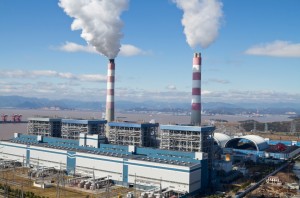
China’s Energy Research Institute (ERI) releases an interesting analysis of the prospects for China’s energy production and consumption and CO2 emissions to 2050
Last November’s joint announcement of national climate targets by President Barack Obama and President of China Xi Jinping has framed the preparations for this December’s crucial Paris summit. The US is aiming to reduce its emissions by 26-28% below the 2005 level in 2025. China intends that its CO2 emissions will peak around 2030 and will use best efforts to bring that date forward. Plainly China’s energy and emissions outlook is highly relevant to the global effort to mitigate climate change and to the Paris negotiations.
The Grantham Institute, Imperial College London, is working with China’s Energy Research Institute and the NDRC on a joint project about China’s role in world energy governance. Improving international cooperation on energy policy is a first order requirement for climate mitigation.
Prof Yang Yufeng, who co-leads this project with me, is also lead author of China Energy Outlook and he has just released, through this presentation given a few days ago in Australia, the preliminary findings of its 2015 edition. (He also introduced their Outlook analysis methodology, the China 2050 Energy Calculator, which was developed independently by his team after studying the analysis platforms of other major international institutions, especially including contributions from DECC’s Energy Calculator).
These findings are of exceptional interest for the light that they shed on the questions, opportunities, and difficulties that China faces in trying to bring forward the peaking of its emissions.
The Outlook suggests that by 2050 China could represent 18.5% of world GDP. By that time China’s industrial structure will have been transformed, with the most energy intensive primary and secondary industries, which dominate today, giving way to tertiary industries at a higher end of the value chain. By then renewables should compete with coal in the mix of power generation, mainly in the form of onshore wind, photovoltaics, gasified biomas, and city waste. But it is a hard task, for China, to free itself from dependence on coal. Today coal represents 66% of energy supply but, according to the Outlook, even in 2050 it may still have more than a one third share.
Most interestingly, the Outlook also offers alternative “high”, “low”, and “medium” scenarios of when critical functions of energy, coal, oil, and gas consumption, and CO2 emissions, will peak. Coal consumption peaks in 2020 in the low case, 2025 in medium, but not until 2030 in high. CO2 emissions peak in 2025 in low, 2030 in medium (which would meet President Xi Jinping’s minimum target), and 2035 in high. We must all hope that China can find the pathway that brings this peak forward to 2025, or even before. It is tantalising to see that in the low cases coal consumption is close to flat from today and CO2 emissions from 2020.
GDP per person in 2050 ranges from $25,000 to nearly $40,000 – a level that would give Chinese citizens incomes commensurate with current levels in the developed countries. The critical issue in China, as in other parts of the world, will be to implement the low carbon options that also support the high end of the range for living standards.
The Energy Research Institute is a research body and their study does not represent Chinese government policy. Nevertheless, it throws very interesting light on the options for energy policy as perceived form within China. The full China Energy Outlook 2015, when it is published in the next half year or so, will no doubt go into much greater depth. Under the close relations between the ERI and the Grantham Institute, we plan to exchange details of the China energy models, and to work together on further refinements.
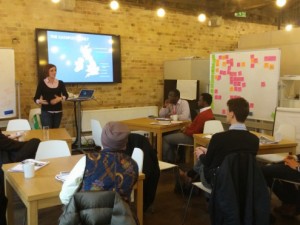 On 9 March a group of students, accompanied by innovation and system thinking coaches, embarked on a Business Innovation Journey organised by NERC and the Grantham Institute. Aiming to tackle NERC’s key challenges through the means of innovation and entrepreneurship, the first week involved visits to the UK’s Catapult centres which take inventions from academia and to turn them into innovations – the perfect space to get inspired.
On 9 March a group of students, accompanied by innovation and system thinking coaches, embarked on a Business Innovation Journey organised by NERC and the Grantham Institute. Aiming to tackle NERC’s key challenges through the means of innovation and entrepreneurship, the first week involved visits to the UK’s Catapult centres which take inventions from academia and to turn them into innovations – the perfect space to get inspired.
On Monday, the students were introduced to the challenges lying ahead of them: the creation of business ideas which would then be presented to an expert panel at the end of the second week. They also visited the Future Cities Catapult where they were given an introduction to the challenges and opportunities that arise in current and future cities. The whole concept of the Catapult System, which is motivated by Germany’s Fraunhofers institutions, was explained, showing how the UK wants to create wealth and prosperity through innovation.
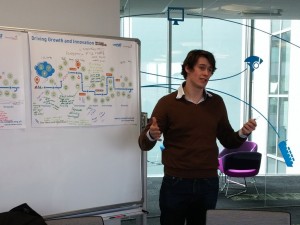 The second day was based in Harwell, at the Satellite Catapult, with a focus on the possibilities of satellite technologies as well as the on-going developments in this domain. In discussions with experts from ESA, Airbus and the Catapult the students discovered the vast opportunities that access to small and very cheap satellites has sparked. This was followed by a visit to the ESA Business Incubation Centre and a discussion with funding bodies where the students were made aware of the ways by which their potential ideas could be funded.
The second day was based in Harwell, at the Satellite Catapult, with a focus on the possibilities of satellite technologies as well as the on-going developments in this domain. In discussions with experts from ESA, Airbus and the Catapult the students discovered the vast opportunities that access to small and very cheap satellites has sparked. This was followed by a visit to the ESA Business Incubation Centre and a discussion with funding bodies where the students were made aware of the ways by which their potential ideas could be funded.
The students then spent the evening exploring common areas of interest and sharing skills and expertise. The lively discussions went on until deep into the night.
The next day was based at the Transport Catapult in Milton Keynes. There the participants considered the challenges and opportunities in the future of transport. Aspects such as minimizing traffic, changing to cleaner means of transport or technologies for electric cars were presented and discussed. Additionally, different ways to model and visualise flows of people and goods, and how they can be used to inform decision makers, were illustrated.
Finally, the participants brainstormed and presented different ways to innovate in the rail sector.
Chris is a Grantham PhD student who helped to develop this program and who is also one of the business innovation coaches. In this blog he provides insights into the program and the experiences the students have gained.
The NERC School for Environmental Innovation and Entrepreneurship would like to invite PhD students and early career researchers with an interest in Environment and Climate Change to register their interest in attending the London Environmental Challenge, a full-time residential course that will run from 13 April to 24 April 2015.
This blog post is part of a series on Responding to Environmental Change event, organised by the Natural Environment Research Council (NERC) funded Doctoral Training Partnerships at Imperial (SSCP), and the University of Reading and the University of Surrey (SCENARIO).
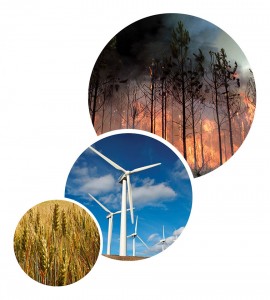
A recent event in London brought together emerging environmental scientists (PhD students and early career researchers) with leaders from business, policy and academia to explore the challenges posed by environmental change and opportunities to work in collaboration to respond to these.
Communities today find themselves and the environments they live in under increasing pressure. This is driven by growing populations, urban expansion and improving living standards that place increasing stress on natural resources. Added to this is the rising threat from environmental hazards and environmental change.
Research, development and innovation within the environmental sciences and beyond offers the opportunity to manage these pressures and risks, exploring how we can live sustainably with environmental change, whatever its drivers.
Discussion at the event covered three key societal challenges and their implications for business and policy. A summary of these talks has been captured by students attending the event and can be found below.
The event was organised by the Natural Environment Research Council (NERC) funded Doctoral Training Partnerships at Imperial (SSCP), and the University of Reading and the University of Surrey (SCENARIO).
Natural resources are fundamental for wellbeing, economic growth and sustaining life. Greater demand for food, water and energy requires better management and use to reduce stress on natural systems and ensure a sustainable future.
Read more in a report by Jonathan Bosch, a first year SSCP PhD student researching transitions to low-carbon energy systems.
Environmental hazards are becoming more frequent and severe, with potentially serious impacts on people, supply chains and infrastructure globally. Advancing our knowledge and understanding of these hazards, and the processes involved, will allow us to better predict, plan for and manage the risks in order to increase resilience to these changes.
Read more in the report by Malcom Graham, a first year SSCP PhD student researching saline intrusion in coastal aquifers.
In addition to natural variability, human activities are causing rapid, large-scale climate and environmental change. Understanding how these processes work as a whole Earth system can improve our understanding of the impacts of these changes and inform responsible management of the environment.
Read more in a report by Rebecca Emerton, a first year SCENARIO PhD student researching approaches to global forecasting of flood risk.
Matthew Bell, Chief Executive at the Committee on Climate Change, concluded the event with a talk on the road to Paris and the issues that could be faced in the climate negotiations.
Read more in a report by Samantha Buzzard, a third year NERC PhD student at Reading investigating the role of surface melt in the retreat and disintegration of Antarctic ice shelves.
Watch videos of all the talks on our YouTube channel.
Find out more about the Science and Solutions for a Changing Planet DTP at Imperial College London.
Find out more about the SCENARIO DTP at the University of Reading and University of Surrey.
This blog post by Jonathan Bosch, an SSCP DTP student, is part of a series on Responding to Environmental Change, an event organised by the Natural Environment Research Council (NERC) funded Doctoral Training Partnerships at Imperial (SSCP), and the University of Reading and the University of Surrey (SCENARIO).
See the full list of blogs in this series here.

Natural resources are fundamental to human well-being, economic growth, and other areas of human development. Greater demand for food, water and energy resources against the current backdrop of climate change and population growth requires better management and more efficient use of natural resources to reduce the resulting stress on the earth’s natural systems.
In this “benefiting from natural resources” section of the programme there were three talks from representatives of three distinct sectors, presenting how the respective areas of industry, regulatory bodies, and academia are currently dealing with the management of natural resources.
Andy Wales, Director of Sustainable Development at SABMiller plc, made an arresting case for why sustainability is not only important for their business model, but also why it’s vital for its continued success. SABMiller is a multinational beer and soft drinks producing company.
SABMiller presents itself as a local beer brand, although it operates in 40 countries. As such, the business is exposed to the perturbations and vulnerabilities of, principally, local water supplies, but also grain and packaging supply chains. And with 80% of its income coming from developing markets, it cannot secure its future profitability without smart resource management. Procuring primary products from local markets is important to achieving this and therefore water management is critical.
The ‘Prosper’ programme, sits on five sustainable development pillars, and has as its catchphrase, “When business does well, so do local communities, economies and the environment around us. When they prosper, we do.” The five pillars are associated with a “thriving, sociable, resilient, clean and productive world.” Encompassed in these areas is an acknowledgement that not only do water supplies matter, but, for example, ‘clean’ – reducing its carbon footprint, and ‘productive’ – food and land security, are central to ensuring a profitable future.
A number of case studies went some way in demonstrating the achievements of Prosper to date. Already, $40m in efficiency savings have been achieved by programmes implemented in Colombia and India, using a systems approach which helped farmers choose better crop types – reducing water consumption by 30% and raising crop yield by 20%.
In Bogota, India, Prosper highlighted issues of poor land management which caused regular and intolerable spikes in water prices. Water run off was high and productive yield of food crops and milk production was low. A sophisticated approach tackled the problem by simply changing the breed of local milk cows to better benefit from the local ecological conditions. The result was an increase in the milk yield of the region and a sharp reduction in water run-off, securing milk and water availability for all users.
Prosper continues to forge collaborations worldwide in the nexus of water, food and energy security. A partnership with the WWF will continue development in that direction.
Miranda Kavanagh, Executive Director, Evidence Directorate of the Environment Agency, focused her talk on ‘Fracking’, or hydraulic fracturing, which is one of the unconventional techniques of oil and gas extraction currently attracting world-wide media attention for its, as yet, undetermined environmental risks.
The Environment Agency’s role is in delivering on a policy framework set by the relevant government agencies, principally DEFRA. It has three specific roles in achieving this objective: Regulating industries and activities that can potentially harm the environment; advising government, industry and the public about more sustainable approaches to the environment; and specific operational work to protect and improve the environment.
The Environment Agency (EA) is guided by its Evidence Directive, which aims to use evidence to “guide and inspire” their actions and those they advise. It states that they must use the best available evidence, use environmental data to support the decisions of others, and develop a joined up approach to evidence, among other equally impressive visions.
On Fracking, the EA must balance, pragmatically, the needs and interests of different groups concerned with environment, resource exploitation and people, as Kavanagh clarified in the Q&A session. As well as the pure environmental impacts, the EA must consider the effects on people and communities, but also the need for fuel exploitation and energy security; areas of interest of both government and the energy sector.
These needs were highlighted in the Potential Contribution report produced by the UK Institute of Directors, which highlighted the social benefits of one scenario to include a likely decrease in the use of imported gas, 70,000 energy jobs and a net benefit to the Treasury.
These benefits are offset by the environmental risks, which are complex, and in some cases, undetermined. The known risks involve a range of air, land and water pollution, the release of chemical and radioactive substances, and a range of spatial and time dependent risks, which will affect exploited regions differently, and on differing timescales. For example, ground water contamination may take decades to become detectable.
The EA works in many areas to produce evidence for the advice and regulation of future potential fracking operations. The EA was, for example, instrumental in producing a UK geological map of the subsurface extent of shales and their vertical separation to aquifers. These were important as a preliminary risk assessment for a broad geological understanding of the importance and distribution of our groundwater resource. This type of evidence gathering must be done for the range of environmental concerns listed above.
Also highlighted were collaborations and opportunities which the EA are eager to develop. NERC Fellowships and various PhD Studentships are ongoing and include projects as broad as evaluating methodologies for environmental risks, but also the invention and patenting of new instruments for air-quality impacts and other applications.
The EA welcomes partnerships, particularly those involved with their Collaborative Research Priorities. Their expertise and extensive datasets are important resources which other organisations with similar resources and objectives may make use of to aid progress on some key questions within applied environmental science.
Elizabeth Robinson, Professor of Environmental Economics at the University of Reading presented two projects demonstrating her work on how scientists and social scientists can and have been working together to improve our ability to benefit from natural resources.
There has been, in the past, little need to actively manage our natural resource base, but the pressures of climate variability and population growth have made optimising the use of these resources effectively much more important. The relationship between ecosystem services – measurable by ecological scientists – and agricultural intensity – understood by management and social structures – becomes a crucial collaboration.
But what is the relationship between these inextricably connected issues? Robinson was concerned, as a trained economist, with ‘drawing a curve’ between these two dimensions, which would describe how and why a change in the intensity of agriculture would affect the ecosystem services which are critical to the sustainability and well-being of communities.
In Ghana, cocoa production was investigated in order to understand how some farmers may choose to intensify their agriculture and why some do not, and furthermore some intensifications were damaging the ecosystem more than others. Ecologists were employed to determine the relationship between intensity and ecosystem services, while social scientists interviewed farming communities to discover how the forest land was managed and what were the limiting factors to best managing the land in benefiting farmer yield and ecosystems.
It was found that there are often complicated social factors affecting how the farms and forest land was managed, and these included the ability of farmers to use or afford fertiliser, shift cultivation to newly converted forest when soils are exhausted, and even whether farmers benefit from pollination by nearby forests. It was seen that many local perceptions of resource space and property rights restricted the farmers’ ability to optimise their practices even if they desired to do so. Among many other constraints, poverty, labour availability and wages, and institutional contexts affect the outcomes when farmers attempted to intensify their practices.
Ultimately, a simple behavioural model can attempt to capture the ecological boundaries, and social constraints, and can be used to propose routes toward an optimum solution for ecosystem services and farmer preferences and resources.
The second case study was related to managing fisheries in Tanzania, where such efforts are typically addressed only when falling stocks become an issue. This project also highlighted the need to observe the socio-economic situation and implement credible solutions which may indeed lead to a slower recovery of the ecology, but which resolve societal tensions and allow the fishing communities a reliable income without implementing a total fishing ban. A ‘Bio-economic’ model was indispensable in this project too.
Watch a video of the talk on our YouTube channel.